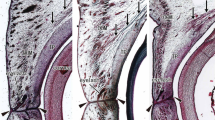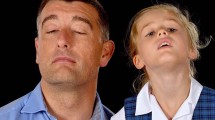Abstract
Purpose
The aim of this study was to investigate the morphometric development of the extraocular muscles in the fetal period and to create a modified Tillaux spiral.
Methods
We dissected 157 fetal eyes (82 right eyes, 75 left eyes) obtained from 79 fetuses (46 boys, 33 girls) between 13 and 40 weeks of gestation. The tendon widths of the extraocular muscles and the distances of the tendon attachment sites to the limbus were measured. Tillaux's modified spiral was created.
Results
In addition to the rectus muscles, we added tendon widths and tendon–limbus distances of the upper (SO) and lower (IO) obliques to the modified Tillaux spiral. When tendon widths were compared between genders, no statistically significant difference was observed. When tendon widths were compared between the sides, it was determined that SO was more in the left eye, whereas other extraocular muscles were more in the right eye. There was no statistically significant difference between genders when the distances of tendon attachment sites to the limbus were compared. There was no statistically significant difference in SO and IO values between the sides. There was a statistically significant difference in the rectus muscles and this difference was found to be higher in the right eye.
Conclusion
We think that the findings obtained will contribute to disciplines such as fetopathology, obstetrics, ophthalmology and plastic surgery and to future studies on this subject.



Similar content being viewed by others
Data availability
Datasets generated and/or analyzed during the current study are available from the corresponding author upon reasonable request.
References
Apt L (1980) An anatomical reevaluation of rectus muscle insertions. Trans Am Ophthalmol Soc 78:365–375
Cass EE (1937) Divergent strabismus. Br J Ophthalmol 21(10):538–559
Chan TK, Demer JL (1999) Clinical features of congenital absence of the superior oblique muscle as demonstrated by orbital imaging. J AAPOS 3(3):143–150
De Gottrau PH, Gajisin S, Roth A (1994) Ocular rectus muscle insertions revisited: an unusual anatomic approach. Cells Tissues Organs 151(4):268–272
Diamond GR, Katowitz JA, Whitaker LA, Quinn GE, Schaffer DB (1980) Variations in extraocular muscle number and structure in craniofacial dysostosis. Am J Ophthalmol 90(3):416–418
Goldstein I, Tamir A, Zimmer EZ, Itskovitz- Eldor J (1998) Growth of the fetal orbit and lens in normal pregnancies. Ultrasound Obstet Gynecol 12(3):175–179
Haas A, Weigleiin A, Faschinger C, Müllner K (1993) Fetal development of the human orbit. Graefes Arch Clin Exp Ophtalmol 231(4):217–220
Harayama K, Amemiya T, Nishimura H (1980) Development of rectus muscles during fetal life: insertion sites and width. Invest Ophthalmol Vis Sci 19(5):468–474
Kleinheinz J, Stamm T, Meier N, Wiesmann HP, Ehmer U, Joos U (2000) Three-dimensional magnetic resonance imaging of the orbit in craniofacial malformations and trauma. Int J Adult Orthodon Orthognath Surg 15(1):64–68
Lacey B, Chang W, Rootman J (1999) Nonthyroid causes of extraocular muscle disease. Surv Ophthalmol 44(3):187–213
Merz E, Wellek S, Püttmann S, Bahlmann WG (1995) Orbital diameter, inner and outer orbital distance. A growth model of fetal orbital measurements. Ultraschall Med 16(1):12–17
Mukhopadhyay S, Chakraborty S, Chatterjee M, Datta H (2014) A study on the insertion characteristics of rectus muscles and its relation with the axial length of eye ball in cadaveric eyes from an eastern Indian population. Anatomy Journal of Africa 3(1):260–267
Plock J, Contaldo C, Von Lüdinghausen M (2007) Extraocular eye muscles in human fetuses with craniofacial malformations: anatomical findings and clinical relevance. Clin Anat 20(3):239–245
Sevel D (1981) A reappraisal of the origin of human extraocular muscles. Ophthalmol 88(12):1330–1338
Sevel D (1986) The origins and insertions of the extraocular muscles: development, histologic features, and clinical significance. Trans Am Ophthalmol Soc 84:488–526
Souza-Dias C, Prieto-Díaz J, Uesugui CF (1986) Topographical aspects of the insertions of the extraocular muscles. J Pediatr Ophthalmol Strabismus 23(4):183–189
Standring S. Gray’s Anatomy: The anatomical basis of clinical practice. 40th Ed. Churchill Livingstone/Elsevier; 2008
Tamburelli C, Salgarello T, Vaiano AS, Scullica L, Palombi M, Bagolini B (2003) Ultrasound of the horizontal rectus muscle insertion sites: implications in preoperative assessment of strabismus. Invest Ophthalmol Vis Sci 44(2):618–622
Tillaux, PJ. Traité d'anatomie topographique avec applications à la chirurgie. 2nd Ed. Asselin et Houzeau; 1877.
Von Lüdinghausen M, Miura M, Würzler N (1999) Variations and anomalies of the human orbital muscles. Surg Radiol Anat 21(1):69–76
Von Noorden GK, Campos EC. Binocular vision and ocular motility. Theory and management of strabismus. 6th ed, Mosby Inc; 2002
Funding
This study was supported by Suleyman Demirel University Instructional Member Training Coordination Unit with project number OYP05444-DR-13. This study was presented as an oral presentation at the 20th National Anatomy Congress.
Author information
Authors and Affiliations
Contributions
BC: protocol/project development, data collection or management, data analysis and manuscript writing/editing. KE: protocol/project development, data collection or management, data analysis and manuscript writing/editing. DA: data collection or management. ÖK: data collection or management. ÖG: data analysis and manuscript writing/editing. TL: protocol/ project development, manuscript writing/editing. TÖ: protocol/ project development, manuscript writing/editing. SO: protocol/ project development, data collection or management, manuscript writing/editing.
Corresponding author
Ethics declarations
Conflict of interest
The authors declare that they have no conflict of interests.
Ethical approval
Approval was obtained from the Faculty of Medicine Ethics Committee for this study (Date: 11.19.2014, Decision no: 185).
Additional information
Publisher's Note
Springer Nature remains neutral with regard to jurisdictional claims in published maps and institutional affiliations.
Rights and permissions
Springer Nature or its licensor (e.g. a society or other partner) holds exclusive rights to this article under a publishing agreement with the author(s) or other rightsholder(s); author self-archiving of the accepted manuscript version of this article is solely governed by the terms of such publishing agreement and applicable law.
About this article
Cite this article
Bilkay, C., Koyuncu, E., Dursun, A. et al. Development of the extraocular muscles during the fetal period. Surg Radiol Anat 46, 11–17 (2024). https://doi.org/10.1007/s00276-023-03269-7
Received:
Accepted:
Published:
Issue Date:
DOI: https://doi.org/10.1007/s00276-023-03269-7




